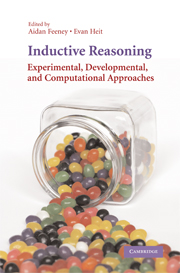Book contents
- Frontmatter
- Contents
- List of Figures
- List of Tables
- List of Contributors
- Preface
- 1 What Is Induction and Why Study It?
- 2 The Development of Inductive Reasoning
- 3 Interpreting Asymmetries of Projection in Children's Inductive Reasoning
- 4 Property Generalization as Causal Reasoning
- 5 Availability in Category-Based Induction
- 6 From Similarity to Chance
- 7 Theory-Based Bayesian Models of Inductive Reasoning
- 8 Use of Single or Multiple Categories in Category-Based Induction
- 9 Abductive Inference: From Philosophical Analysis to Neural Mechanisms
- 10 Mathematical Induction and Induction in Mathematics
- 11 Induction, Deduction, and Argument Strength in Human Reasoning and Argumentation
- 12 Individual Differences, Dual Processes, and Induction
- 13 Taxonomizing Induction
- Index
10 - Mathematical Induction and Induction in Mathematics
Published online by Cambridge University Press: 26 February 2010
- Frontmatter
- Contents
- List of Figures
- List of Tables
- List of Contributors
- Preface
- 1 What Is Induction and Why Study It?
- 2 The Development of Inductive Reasoning
- 3 Interpreting Asymmetries of Projection in Children's Inductive Reasoning
- 4 Property Generalization as Causal Reasoning
- 5 Availability in Category-Based Induction
- 6 From Similarity to Chance
- 7 Theory-Based Bayesian Models of Inductive Reasoning
- 8 Use of Single or Multiple Categories in Category-Based Induction
- 9 Abductive Inference: From Philosophical Analysis to Neural Mechanisms
- 10 Mathematical Induction and Induction in Mathematics
- 11 Induction, Deduction, and Argument Strength in Human Reasoning and Argumentation
- 12 Individual Differences, Dual Processes, and Induction
- 13 Taxonomizing Induction
- Index
Summary
However much we may disparage deduction, it cannot be denied that the laws established by induction are not enough.
Frege (1884/1974, p. 23)At the yearly proseminar for first-year graduate students at Northwestern, we presented some evidence that reasoning draws on separate cognitive systems for assessing deductive versus inductive arguments (Rips, 2001a, 2001b). In the experiment we described, separate groups of participants evaluated the same set of arguments for deductive validity or inductive strength. For example, one of the validity groups decided whether the conclusions of these arguments necessarily followed from the premises, while one of the strength groups decided how plausible the premises made the conclusions. The results of the study showed that the percentages of “yes” responses (“yes” the argument is deductively valid or “yes” the argument is inductively strong) were differently ordered for the validity and the strength judgments. In some cases, for example, the validity groups judged Argument A to be valid more often than Argument B, but the strength groups judged B inductively strong more often than A. Reversals of this sort suggest that people do not just see arguments as ranging along a single continuum of convincingness or probability but instead employ different methods when engaged in deductive versus inductive reasoning.
Earlier imaging evidence by Goel, Gold, Kapur, and Houle (1997) and by Osherson et al. (1998) had implicated separate brain regions when participants evaluated arguments for validity versus plausibility, and these earlier data had inspired our own experiment. All these results cast doubt on the view that there's a homogeneous “analytic” reasoning system responsible for correctly solving deductive and probabilistic problems.
- Type
- Chapter
- Information
- Inductive ReasoningExperimental, Developmental, and Computational Approaches, pp. 248 - 268Publisher: Cambridge University PressPrint publication year: 2007
- 2
- Cited by



